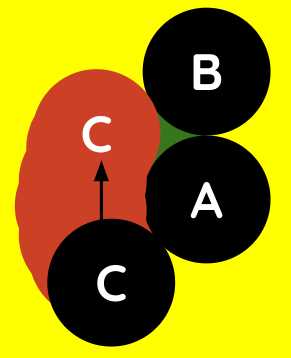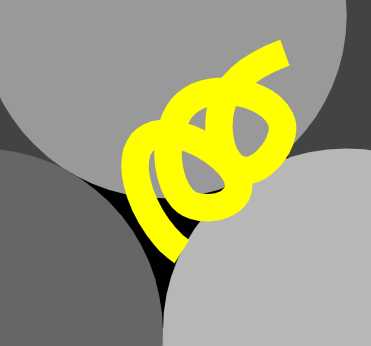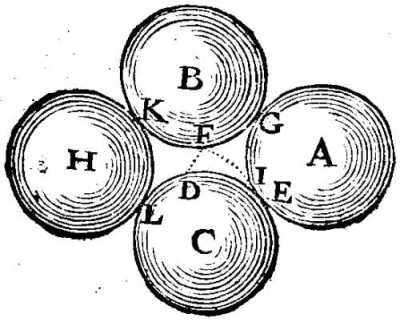The Striated Particles [Virtual Photons] of the Fire-Aether
Table of Contents
Superphysics Note
87. The Various Degrees of Speed in the Minute Parts of the Fire-aether
The fire-aether does not have a single speed.
Often in a very small quantity, different degrees of speed are found.
This is because they came from the worn down particles of the air-aether.
The purpose of the fire-aether is to fill all the narrow spaces found around other bodies.
Hence, each of its minute parts was initially no larger than the angles of the particles from which they were cut, or than the space left in the middle by three mutually touching globules.
Therefore:
- some of them remained perfectly undivided
- others had to be indefinitely divided
- These exited from narrow spaces whose shape was changing more and more.
For example, let there be 3 globules ABC. A and B mutually touch and rotate only around their own centers.

C touches A and rolls over to red C.
The fire-aether in the the green area can remain immobile.
But the fire-aether in the red space must necessarily move.
88. Those slowest of the small particles easily transfer to others what little speed they have and then fuse to each other.
Among the fire-aether are particles which are less divided than the rest, and less rapidly agitated.
These easily:
- fuse to each other
- transfer most of their agitation into those other most minute fragments, which are agitated most rapidly.
This is because larger bodies, other things being equal, more easily transfer their agitation into smaller ones, than receive from those smaller than they.
89. Such sticking minute parts are mainly found in the fire-aether which move from the poles to the vortex center
Such fire-aether move from the poles towards the center of their vortex in straight lines.
The least agitated particles go in a straight motion.
But the other particles which follow more oblique and varied motions are usually expelled from the path of this straight motion.
Then they gather into small masses.
90. What is the shape of these small particles, which I will call striated particles or virtual photons
The middle of 3 air-aether globules touching each other create narrow triangular spaces. These virtual photons must take on a triangular shape in their width and height when they pass through these.
Their length is not easy to determine because it only depends on the abundance of fire-aether in them.
They are small columns, hollowed out with 3 spirals like screw-threads. This lets them pass through those narrow passages while twisting, having the shape of a curvilinear triangle FGI.
This triangular hole is always found between the 3 air-aether globules touching each other.
The virtual photons are elongated and pass very rapidly between those air-aether globules which rotate around the poles of the gravitational territory.

This is why those virtual photons must have screw-threads to pass through those rotating globules very quickly.
They would be more twisted the closer they are to the axis of the vortex and less twisted the farther away.
This is because the air-aether globules rotate faster near the axis.
91. These virtual photons coming from opposite poles are twisted in contrary directions
They come towards the middle of the gravitational territory from opposite parts.
- some come from the South Pole
- others come from the North Pole
This happens while the entire vortex rotates around its axis.
Those which come from the South Pole are twisted in the opposite way as those which come from the North Pole.
Magentic forces chiefly depend on this.
92. They only have 3 striations
These virtual photons can only have 3 striations.
The air-aether globules cannot always touch each other in such a way that only triangular spaces remain around them.
Any larger spaces found among these globules always have their angles exactly equal to those of the triangle FGI. The rest are in perpetual change.
The virtual photons passing through them must also take on this shape.
For example, the globules A, B, C, H touch each other at points K, L, G, E.

They leave in their middle a quadrilateral space. Each of its angles is equal to each of the angles of the triangle FGI.
As these 4 globules move, that space continually changes shape.
- It sometimes becomes square, sometimes oblong.
- It even occasionally divides into two other triangular spaces.
Thus, the less agitated fire-aether existing in it must flow to one or two of its angles.
This leaves the rest of the space to the more mobile matter that more easily changes its shapes to accommodate all the movements of those globules.
If one of its fragments, existing in one of these angles, extends itself toward the part opposite that angle, beyond a space equal to the triangle FGI, it must be expelled from there and thus diminished when a third globule touches the two that form the angle it occupies.
For instance, if the less agitated matter occupying angle G extends itself towards D beyond the line FI, it will be driven out by globule C.
- This will diminish it as globule
CapproachesBto close the triangleGFI.
The largest fire-aether particles are less agitated than the rest.
They pass through long tracts of the sky. They often find themselves between 3 approaching globules.
They are not able to take on any definite shape that remains in them for a while, other than the one we have described.
93. The various sizes of fire-aether particles among the virtual photons and minute particles
These elongated virtual photons differ greatly from the rest of the fire-aether.
Yet, I do not distinguish them from it as long as they are only among the air-aether globules. This is because:
- we do not notice any particular effect of them there, and
- we believe many others are contained in it
- These are not much smaller and not more swiftly agitated
Between the very smallest particles and these virtual photons, there are innumerable other grades, as can be easily recognized from the inequality of the paths they pass through.